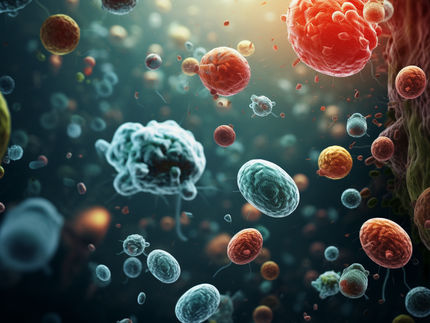Rapid test for the detection of Salmonella in food
Advertisement
No one is immune to infection with salmonella, but infants, toddlers, the elderly and people with an attacked immune system are particularly frequently affected. In people with a weakened immune system, gastrointestinal disease can lead to considerable complications. So far, it takes several days to detect salmonella in food. A new rapid test developed by Fraunhofer researchers is designed to detect the germs in less than eight hours.

Food poisoning by salmonella occurs again and again. Raw meat is a common source of infection. If the ground pork roll were contaminated with the pathogens, eating it could lead to vomiting, diarrhoea and abdominal cramps.
Fraunhofer IZI-BB
Watery, persistent diarrhoea, vomiting, fever, abdominal pain - anyone suffering from these symptoms could be affected by a salmonella infection. By eating infected animal foods such as eggs, egg products such as mayonnaise, milk, poultry, seafood and raw meat, the bacteria enter the gastrointestinal tract and trigger the typical signs of disease. The problem: Up to now it has taken up to four days to detect salmonella in animal products using classical microbiological methods. For food manufacturers, this process takes too long - they cannot wait for the result until their goods are delivered. As a result, expensive recall campaigns are repeatedly carried out. Much shorter detection methods are therefore required. Together with SELEKTIS GmbH, a research team at the Fraunhofer Institute for Cell Therapy and Immunology IZI-BB, Bioanalytics and Bioprocesses Division in Potsdam is developing a rapid test that can determine whether food is contaminated with salmonella in less than eight hours. The Investment Bank of the State of Brandenburg (ILB) and the State of Berlin (IBB) are supporting the project with funding from the European Regional Development Fund (ERDF).
Enrichment process reduced to four to six hours
A lot of time has been required to enrich the bacteria: Microbes, which are only present in small quantities, are cultivated and propagated overnight in a liquid culture medium so that a sufficiently high bacterial count is available for subsequent detection. This process has taken about 18 hours so far, and three more days are required for the selective enrichment and incubation of Salmonella in additional liquid media, the smearing of a bacterial culture on agar plates and the serological test. The project partners have already succeeded in reducing the first lengthy enrichment process from 18 hours to four to six hours. This goal was achieved with the help of an innovative method for cultivating salmonella: "We succeeded in doing this by creating a rapid culture with growth conditions optimized for salmonella. A subsequent innovative, optimized enrichment method enables us to increase the concentration of the bacteria to such an extent that we can subsequently detect them using molecular biological methods after just a few hours. For this purpose, the DNA of Salmonella is amplified and then automatically detected. For this purpose we extract the DNA of the salmonella and multiply it molecularly so far that it can be detected after another 30 minutes. For the rapid test, we are designing the molecules that specifically detect the DNA of salmonella," explains Dr. Harald Peter, scientist at Fraunhofer IZI-BB. It is crucial to obtain the highest possible concentration of Salmonella DNA for sensitive detection within a short time. Using fluorescent dyes, the researchers can label the amplified DNA and detect it using capture molecules.
Automated system for sample preparation and pathogen detection planned
Although molecular biological detection methods are already used in laboratories, they are still rarely used in a fully automated form and have not yet been applied in food diagnostics. In order to achieve this, Dr. Peter and his team are planning a system that will automate all processes that are currently still carried out manually, such as cultivation, enrichment, molecular-biological amplification and detection. In the future, all necessary components will be integrated into a compact device measuring around 40 by 40 centimetres. With some special molecular biological methods, the researchers at Fraunhofer IZI-BB can, for example, dispense with certain DNA purification steps, thus considerably simplifying and accelerating the process.
"According to the Food Hygiene Ordinance, a sample of 25 grams of meat may not contain a single salmonella. The new rapid test must therefore be able to detect a single bacterium within a total of six to eight hours, i.e. within one working shift. Another task is to differentiate salmonella from other microorganisms," said Dr. Peter describing the challenge. The advantage: the test can also be transferred to other food pathogens. All that is required is to adapt the capture molecules to other organisms on the computer using gene databases.
Note: This article has been translated using a computer system without human intervention. LUMITOS offers these automatic translations to present a wider range of current news. Since this article has been translated with automatic translation, it is possible that it contains errors in vocabulary, syntax or grammar. The original article in German can be found here.
Other news from the department science
Most read news
More news from our other portals
See the theme worlds for related content
Topic world Food safety
Food safety is at the heart of the food and beverage industry. It ensures that the food we eat every day is not only nutritious, but also free of harmful contaminants. From field to plate, the industry monitors and regulates every step of the process with strict quality controls, advanced testing methods and continuous research.

Topic world Food safety
Food safety is at the heart of the food and beverage industry. It ensures that the food we eat every day is not only nutritious, but also free of harmful contaminants. From field to plate, the industry monitors and regulates every step of the process with strict quality controls, advanced testing methods and continuous research.




























































